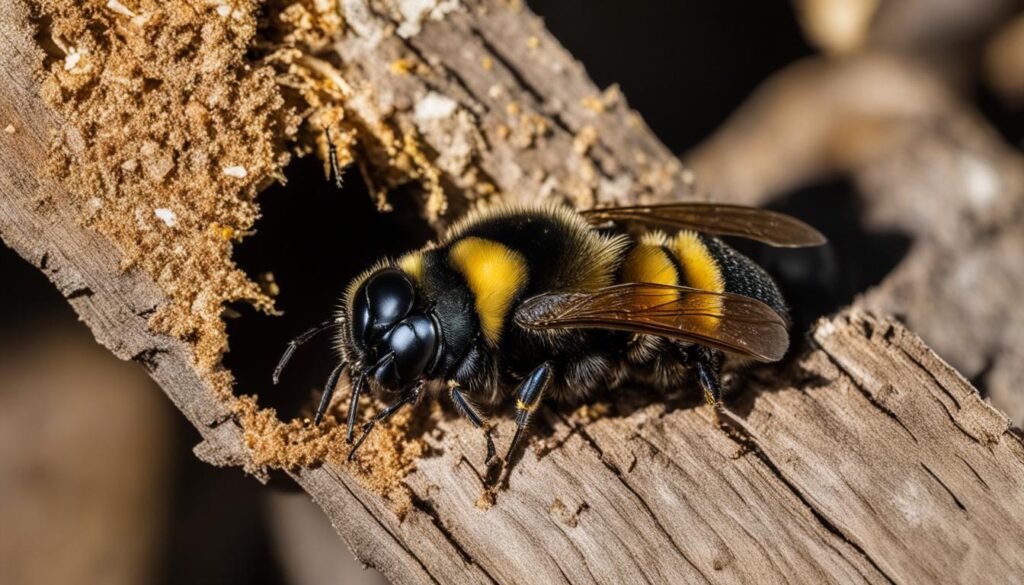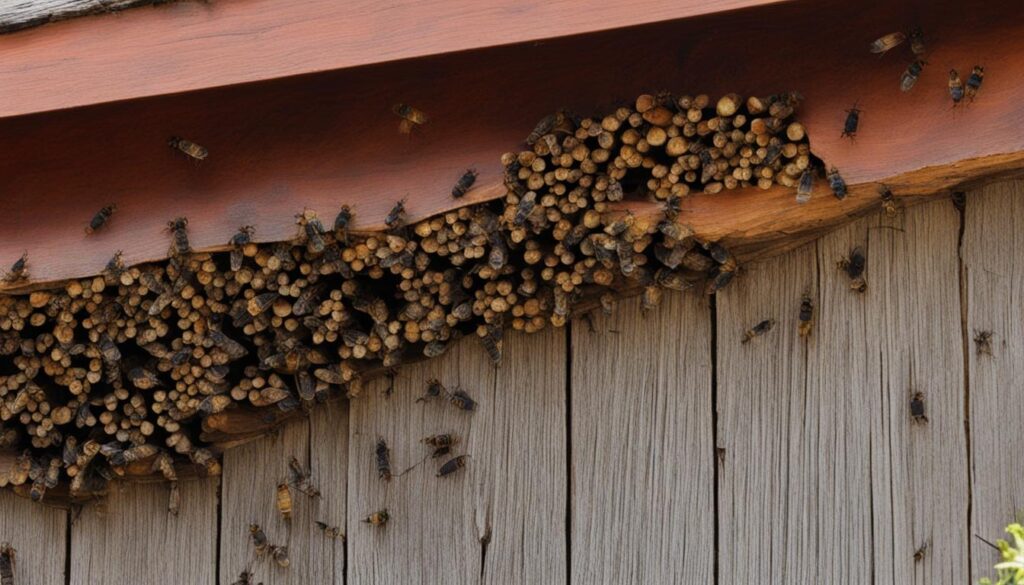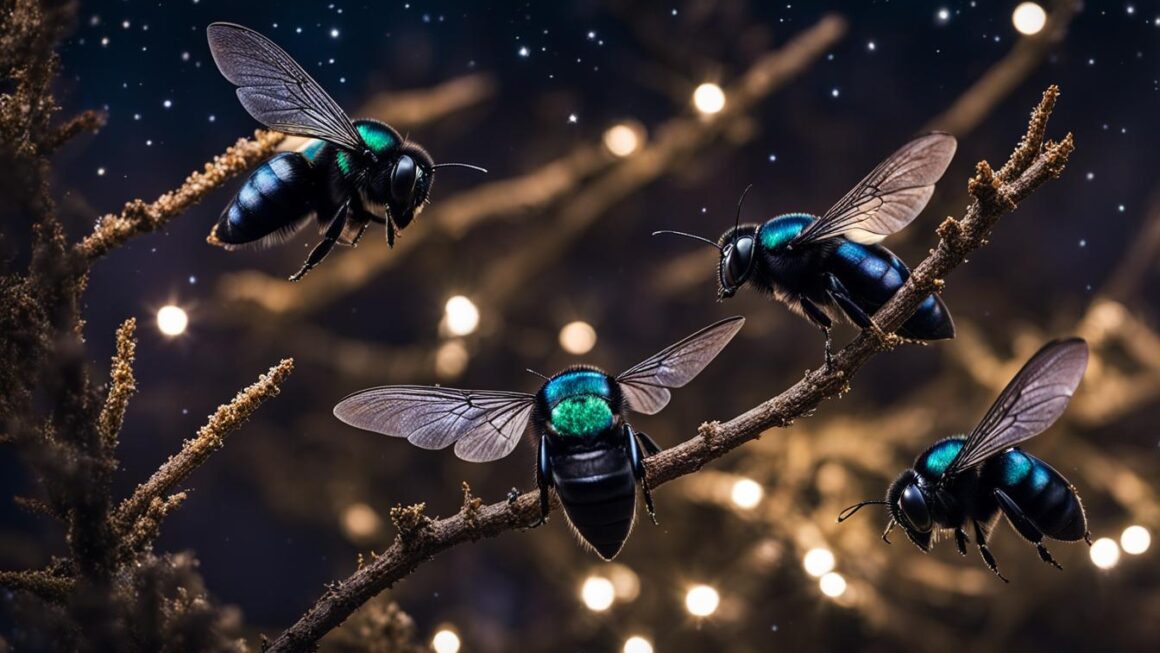Carpenter bees are fascinating insects known for their burrowing abilities and vital role in pollination. If you’ve ever wondered about their behavior and activity patterns, specifically whether carpenter bees come out at night, you’re in the right place. In this comprehensive guide, we’ll explore the diurnal habits of carpenter bees, their nighttime behavior, and how to coexist with these beneficial creatures.
Key Takeaways:
- Carpenter bees are diurnal insects, meaning they are most active during the day.
- They begin foraging for pollen and nectar early in the morning and return to their nests at dusk.
- Carpenter bees enter a state of torpor at night to conserve energy.
- Accessing carpenter bee nests at night can be more challenging and potentially dangerous.
- It is recommended to address carpenter bee infestations before they emerge from winter hibernation.
Carpenter Bee Behavior and Habits
Carpenter bees are fascinating creatures with unique behavior and habits. They are solitary bees that create individual nests by burrowing into wood. Unlike honey bees, they do not have shared hives or colonies. Carpenter bees play a vital role in plant pollination as they are attracted to brightly colored flowers. They forage for pollen and nectar during the day and rest in their nests at night.
Female carpenter bees are capable of stinging but usually only do so when provoked. Males, on the other hand, are territorial and guard the nests. Females protect the eggs and larvae, ensuring their safety and development. These industrious insects exhibit diurnal behavior, being most active during the day and entering a state of torpor at night to conserve energy.
“Carpenter bees are solitary bees that burrow into wood to create individual nests.”
Understanding carpenter bee behavior and habits can help homeowners coexist peacefully with these beneficial pollinators. By providing wooden structures, such as nesting blocks, and planting attractive flowers, you can support their nesting and foraging activities. However, it is important to be mindful of their nests and avoid disturbing them to prevent defensive behavior or potential structural damage.
| Carpenter Bee Behavior and Habits | Description |
|---|---|
| Diurnal Behavior | Carpenter bees are most active during the day, foraging for pollen and nectar. |
| Solitary Nesting | They create individual nests by burrowing into wood, providing protection for their offspring. |
| Male Territorialism | Males guard the nests, ensuring the safety of the eggs and larvae. |
| Female Stinging | Females are capable of stinging but typically only do so when provoked. |
By respecting and appreciating the behavior and habits of carpenter bees, we can coexist with these important pollinators while also protecting our wooden structures and maintaining a harmonious environment.
Where Do Carpenter Bees Go at Night?
Carpenter bees are fascinating insects with unique behaviors and habits. While they are primarily diurnal, being most active during the day, they also have specific behaviors at night. When the sun sets, carpenter bees retreat to their nests, which are typically burrowed into wood. These nests provide a secure and hidden spot for the bees to rest and protect themselves.
During the night, carpenter bees enter a state of torpor, which is a decreased physiological activity that helps conserve energy. This allows them to maintain their energy levels for their foraging and nest-building activities during the day. Similar to hibernation, carpenter bees may also hibernate in their nests during colder months until the weather becomes warmer.
Understanding where carpenter bees go at night is essential in managing their behavior and potential interactions with humans. By knowing that they retreat to their nests for protection and rest, homeowners can take appropriate measures to address carpenter bee infestations without disturbing the bees during their inactive periods.
Overall, carpenter bees have fascinating activity patterns that revolve around their unique nesting habits. The next section will delve into the potential dangers and human interactions with carpenter bees, shedding light on key considerations when coexisting with these important pollinators.
The Table: Comparing Carpenter Bee Activity Patterns
| Daytime Activity | Nighttime Activity | |
|---|---|---|
| Carpenter Bees | Foraging, nest-building, pollination | Resting in nests, torpor |
| Honey Bees | Foraging, hive maintenance, pollination | Inactive, clustering in hives |
| Bumble Bees | Foraging, pollination, nest-building | Resting, clustering in nests |
Carpenter Bees and Human Interaction
Carpenter bees are generally not aggressive toward humans and do not pose a significant threat. However, they may become defensive if their nests are disturbed or they feel threatened. Male carpenter bees, although territorial, do not have stingers and are harmless. On the other hand, females do have stingers but usually only sting when provoked or under pressure.
It is important to note that female carpenter bees are less likely to sting than other types of bees, such as honey bees or wasps. Their primary focus is protecting their nests and offspring, rather than actively seeking out human interaction. However, if a female carpenter bee feels threatened or cornered, she may sting to defend herself.
“Carpenter bees are generally not aggressive toward humans but can become defensive if their nests are disturbed.”
When dealing with carpenter bee infestations, it is crucial to exercise caution and take appropriate measures. It is recommended to address carpenter bee nests during daylight hours when the bees are less active and less likely to be disturbed. This reduces the chances of triggering defensive behavior.
| Carpenter Bee Interaction with Humans | Risk Level |
|---|---|
| Male carpenter bees hovering around faces | Low risk, as they do not have stingers |
| Female carpenter bees feeling threatened or provoked | Low to moderate risk, as they have stingers but usually only sting under certain conditions |
In conclusion, while carpenter bees may exhibit defensive behavior if their nests are disturbed, they generally do not pose a significant danger to humans. Taking precautions and addressing carpenter bee infestations during daylight hours can help minimize any potential interactions or stings.
Nesting and Reproduction Habits of Carpenter Bees
Carpenter bees have fascinating nesting and reproduction habits that contribute to their role as important pollinators in ecosystems. Understanding these habits can provide valuable insights into their behavior and help homeowners manage carpenter bee infestations effectively.
Life Cycle and Nesting Behavior
The life cycle of a carpenter bee begins when a female creates a tunnel in wood, typically in structures like wooden beams, eaves, or fences, to lay her eggs. These tunnels are meticulously crafted and can extend several inches deep into the wood. The female then provisions each tunnel with a mixture of pollen and nectar, which will serve as food for the larvae when they hatch.
After the eggs are laid, they develop into larvae, which feed on the stored food until they pupate. During the pupal stage, the larvae develop into adult carpenter bees within the safety of the tunnel. Once fully developed, the new generation of carpenter bees emerges from the tunnel, ready to continue the cycle.
Egg-laying and Brood Protection
Female carpenter bees take great care in selecting appropriate sites for their nests. They are attracted to unpainted or untreated wood, as these surfaces are easier to burrow into. The female uses her strong mandibles to excavate the tunnels, creating a secure chamber for each egg. She then seals each chamber with a mixture of wood pulp and saliva, protecting the developing brood from external threats.
Role of Males in Nest Defense
Male carpenter bees play a crucial role in protecting the nests from potential threats. They are territorial and often stationed near the nest entrance, aggressively defending it against intruders. However, male carpenter bees do not possess stingers and are incapable of inflicting stings. Their behavior may appear intimidating, but they are harmless and primarily focused on protecting their territory.
| Carpenter Bee Nesting and Reproduction Habits | Key Points |
|---|---|
| Life Cycle | Carpenter bees go through a complete metamorphosis, beginning as eggs, developing into larvae, pupating, and emerging as adult bees. |
| Tunnel Excavation | Females create tunnels in untreated wood, carefully crafting each chamber for egg-laying and brood development. |
| Brood Protection | Females seal the chambers with wood pulp and saliva to protect the developing brood from external threats. |
| Male Defense | Males guard the nest entrance but are harmless as they lack stingers. |
The nesting and reproduction habits of carpenter bees highlight their remarkable adaptations for survival and reproduction. By understanding these behaviors, homeowners can take appropriate measures to manage carpenter bee populations and protect structures from damage.

Carpenter Bees and Wood Structures
Carpenter bees can pose a threat to wood structures due to their nesting habits. One of the most noticeable signs of carpenter bee activity is the presence of circular holes in the wood surface, often accompanied by piles of sawdust below the holes. These holes can weaken wooden beams, eaves, and rafters over time, potentially leading to structural issues. Additionally, the sawdust and wood shavings created by carpenter bees can clog up ventilation systems and attract other pests, such as woodpeckers and termites.
To better understand the effects of carpenter bee nests on wood structures, here are some key signs of carpenter bee damage:
- Circular holes in wood surfaces, typically around ½ inch in diameter
- Piles of sawdust or wood shavings below the holes
- Weakening of wooden beams, eaves, and rafters
- Potential attraction of other pests, such as woodpeckers and termites
It is important to address carpenter bee infestations promptly to prevent further damage and potential structural issues. Regular maintenance of wooden structures, such as sealing cracks and painting or varnishing exposed wood surfaces, can help deter carpenter bees from nesting. If carpenter bees have already established nests, filling the holes with steel wool or compressed tin foil and sealing them can effectively remove the bees and prevent reinfestation. Taking these preventive measures can help protect wood structures from the damaging effects of carpenter bees.
Table: Signs of Carpenter Bee Damage to Wood Structures
| Signs of Carpenter Bee Damage | Description |
|---|---|
| Circular holes | Visible holes in wood surfaces, typically around ½ inch in diameter |
| Sawdust or wood shavings | Piles of sawdust or wood shavings below the holes |
| Weakened wooden structures | Wooden beams, eaves, and rafters can be weakened over time |
| Attracting other pests | Carpenter bee nests may attract woodpeckers and termites |

“Carpenter bees can weaken wooden structures and attract other pests if left untreated. Identifying the signs of carpenter bee damage, such as circular holes and piles of sawdust, is crucial for early intervention. Regular maintenance and prompt removal of nests can help protect wood structures from potential structural issues.”
Are Carpenter Bees Dangerous?
Carpenter bees are generally not aggressive and pose little danger to humans. However, they do have the ability to sting if provoked or handled. Female carpenter bees have stingers but typically only use them in self-defense or under pressure. Male carpenter bees, on the other hand, do not have stingers and are essentially harmless. Despite their limited aggression towards humans, carpenter bees can still cause damage to wooden structures over time, which can lead to potential dangers.
One of the main concerns with carpenter bees is the structural damage they can inflict on wood. As these bees burrow into wood to create their nests, they create circular holes on the surface. Over time, the weakening of wooden beams, eaves, and rafters can result in structural issues. Moreover, the sawdust and wood shavings produced by carpenter bees can clog up ventilation systems and attract other pests, such as woodpeckers and termites.
“While carpenter bees may not pose an immediate danger to humans, it is important to address infestations promptly to prevent potential risks associated with structural damage.”
By promptly addressing carpenter bee infestations, homeowners can mitigate the potential dangers associated with structural damage. Regular maintenance of wooden structures, such as painting or varnishing exposed wood surfaces, can help prevent carpenter bees from burrowing into the wood. Additionally, sealing existing holes with steel wool or compressed tin foil can deter carpenter bees from nesting in those areas. If necessary, pest control products containing carbaryl, cyfluthrin, or resmethrin can be used to kill adult and young bees.
| Dangers of Carpenter Bees | Carpenter Bee Stings | Carpenter Bee Structural Damage |
|---|---|---|
| Carpenter bees can cause structural damage to wooden beams, eaves, and rafters over time. | Female carpenter bees have stingers but usually only sting when provoked or under pressure. | As carpenter bees burrow into wood, they create circular holes on the surface and weaken the overall structure. |
| The sawdust and wood shavings produced by carpenter bees can clog up ventilation systems. | Male carpenter bees do not have stingers and are harmless to humans. | The weakened wood can attract other pests, such as woodpeckers and termites. |
By understanding the potential dangers and taking proactive measures to control carpenter bee infestations, homeowners can maintain the integrity of their wooden structures and ensure a safe environment.
How to Get Rid of Carpenter Bees
Carpenter bee infestations can be a nuisance and cause damage to wooden structures over time. If you’re dealing with carpenter bees, it’s important to take action to prevent further infestations and protect your property. Here are some effective methods to get rid of carpenter bees and prevent their return:
1. Filling and Sealing Holes
One of the simplest ways to address existing carpenter bee nests is by filling the holes with steel wool or compressed tin foil. This blocks their access to the tunnels and discourages them from returning. Seal the filled holes with wood putty or caulk to prevent re-entry.
2. Regular Maintenance
Regularly inspect and maintain wooden structures to prevent carpenter bee infestations. Fill any cracks or gaps in the wood, as these can serve as entry points for bees. Additionally, painting or varnishing exposed wood surfaces can make them less attractive to carpenter bees.
3. Pest Control Products
If you’re dealing with a persistent carpenter bee problem, you may consider using pest control products specifically designed for carpenter bees. These products usually contain ingredients like carbaryl, cyfluthrin, or resmethrin, which are effective in killing adult bees and young larvae. Follow the instructions on the product label carefully to ensure safe and effective use.
By taking these proactive measures, you can effectively manage and prevent carpenter bee infestations, protecting your property from potential structural damage.
Conclusion
Managing carpenter bee infestations is essential for protecting wooden structures and maintaining a harmonious environment. By implementing preventive measures and taking prompt action, homeowners can effectively prevent and control carpenter bee populations.
Regular maintenance of wooden structures, such as painting or varnishing exposed wood surfaces, can deter carpenter bees from nesting. Filling existing holes with steel wool or compressed tin foil and sealing them off helps eliminate active nests.
In cases where carpenter bee populations become overwhelming, pest control products containing carbaryl, cyfluthrin, or resmethrin can be used to kill adult bees and disrupt their reproductive cycle. However, it is important to follow the manufacturer’s instructions and take necessary precautions when using these products.
By staying vigilant and proactive in carpenter bee prevention, homeowners can avoid structural damage and enjoy a bee-friendly environment. Remember, carpenter bees play a vital role in pollination, so it is crucial to balance their presence with the need to protect wooden structures.
FAQ
Do carpenter bees come out at night?
Carpenter bees are generally not very active at night and prefer to be active during the day.
Where do carpenter bees go at night?
Carpenter bees retreat to their nests at night for protection and rest.
Are carpenter bees dangerous?
Carpenter bees are generally not aggressive towards humans but can become defensive if their nests are disturbed.
What are the nesting and reproduction habits of carpenter bees?
Females lay their eggs in tunnels they create in wood and provide them with food made up of pollen and nectar.
What damage can carpenter bees cause to wooden structures?
Carpenter bee nests can weaken wooden beams, eaves, and rafters over time, potentially leading to structural issues.
How can I get rid of carpenter bees?
The most effective way to get rid of existing carpenter bee nests is by filling the holes with steel wool or compressed tin foil and sealing them. Regular maintenance of wooden structures and painting or varnishing exposed wood surfaces can help prevent carpenter bee infestations.




